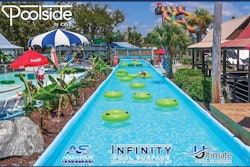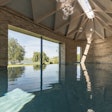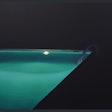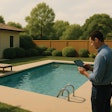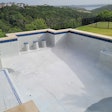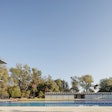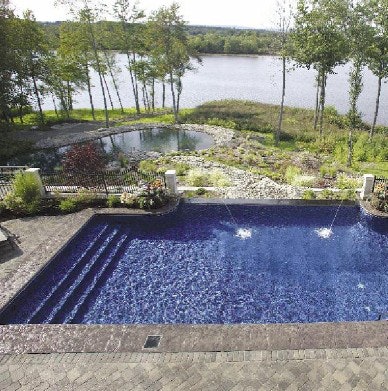
Not so many years ago, customers who wanted a vanishinge-dge pool had to go with gunite. Today, this is certainly not the case.
According to Michael A. Giovanone, president of Latham, N.Y.-based Concord Pools, vinyl-liner pools can now fit the bill as well. "I have a tongue-incheek comment that years ago you could buy any shaped vinyl-liner pool that you wanted as long as it was a rectangle. That's not true today.
"We have no limits. We can mold any shape somebody can draw. We didn't have the strength to do this five or 10 years ago in panels. We certainly do now."
Giovanone recently built a $60,000, 17-by-34-foot, 23,000-gallon vanishinge-dge vinyl-liner pool for Saratoga Springs, N.Y., homeowners who wanted to walk out of their home and into the pool area — even though their house was built at the top of a bluff with a 27-foot elevation between their back door and the lake beyond.
To unify the yard, the finished project is set up to create the illusion that water from the pool flows over the vanishing edge, down a stream and into a pond, but in fact it does not, Giovanone says. Water in the pool's catch basin is returned to the pool, and the stream that appears to originate at the pool's catch basin is actually water flowing out of a separate basin next to the pool's catch basin.
The project also features radiant-heated floors, a self-winterizing system, fiber-optic lighting and a spring-fed pond.
Around the pool Giovanone installed patterned concrete and pavers. "I like pavers in elevated locations," he says. "They are forgiving, so if a little bit of movement happened, pavers will forgive much like the structural resin pool will."
Getting Started
When Concord began this project, Giovanone and his crew created a series of concrete retaining walls and soil berms because the homeowners wanted the pool right outside their back door, and with the 27-foot grade change, a significant support system had to be created (See Figure 1). "That was a 14-foot-high wall, but only 4-feet of it shows because we bermed-up soil to create a slope grade," Giovanone says. After this step, a 90-meter concrete pump was brought in to pour a concrete wall system, establishing upper elevations.
With the retaining walls in place (See Figure 2), 3,000 cubic yards of compactable gravel was set. In order to produce a project of this magnitude, Giovanone says he had to pay close attention to the velocity and volume of the water being pumped.
"The one thing most builders miss is if you're in a negative-edge situation and you're dealing with a water feature and/or a catch pool, you want high volume, low velocity," Giovanone explains.
To allow for some tweaking as the project progresses, Giovanone likes to use the following technique: "If you oversize a line, you can always add a pump or increase a pump size. As a builder, I'd much rather run a 3-inch line than a 2-inch line knowing it's there, and if I don't get the effect I want I can up the pump to a 3horse and add another 30 gallons a minute to the feature through that line."
- With a 27-foot elevation between the existing ground and the desired pool location, a series of concrete retaining walls and soil berms had to be created.
- Retaining walls and 3,000 cubic yards of compactable gravel fill have been put in place.
- Rough pool layout is drawn in preparation for pool excavation.
- Panels and integral I-braces have been set and are ready for the first pour of the concrete bonding beam.
- The lower catch pool is built on the lower level.
- The catch pool and adjacent pond water basin are in place.
- The liner has been installed and the black granite weir is in place.
Placing The Pool
Giovanone continues building by roughing out a pool layout in preparation for excavation (See Figure 3), with the bottom of the pool sitting at 13-feet above the original grade. By this time, the rock-lined stream that leads to the pond has also been installed.
Once the pool is dug, Giovanone sets the pool's panels, utilizing the 18inch-thick upper retaining structure as the weir wall (which drops 6 feet into the catch pool). Panels and integral I-braces are then set and readied for the first pour of the concrete bonding beam (See Figure 4). "The structure is in place, and the bonding beam gets poured around the base of all the panels and braces and locks everything in," says Giovanone.
A solid, radiant-heated concrete bottom and the pool's steps are then placed. Although a radiant-heated-floor is more expensive than a typical heater, Giovanone says it is more efficient, and after five years homeowners can recoup the money they spent on the installation.
To install this type of flooring, : inch radiant-heat tubing is run under the floor of the pool. The tubing is hooked into a boiler, and Glycol, an antifreeze, moves slowly through the lines, heating the pool from the floorup. "The beautiful thing about this is that with the popularity of placid water, we can shut the pool off for a dinner party and it will still be heating," says Giovanone. "You shut off a pool with a standard heater on it and it goes cold because the heater is not running. Once the radiant-heated floor heats up, it's like a rock in the sun. The sun goes down, the rock is warm for hours afterwards."
Once the flooring is in place, the cantilevered coping is poured. "You put the form up, it overhangs the wall, then you strip the form, and then you have a nice, concrete, round cantilever effect, almost to assimilate cut rock," Giovanone says.
Building The Catch Pool
A lower catch pool is then built on a lower level of the project (See Figure 5) and catch pool drains are roughed in and split six times in order to assure high-volume, low-velocity hydraulics.
"What we did is we brought the main trunk through, split it six times, and now I can draw that pool down to approximately 6 inches without vortexing, while delivering 150 gallons of water per minute to the water feature above."
Because bathers can create surges in the system's flow, Giovanone says, "You also have to install your overflow and your make-up water, or your auto-fill. It's very important those are both done in the catch pool." If the auto-fill is placed in the main pool, Giovanone says, a windy day could cause the pool's water to run over the weir, and the auto-fill to run continuously.
Once the pool's catch basin and adjacent pond basin are completed (See Figure 6), Giovanone and his crew install a liner from Pacific Industries, Latham, N.Y., and set the black granite weir in place (See Figure 7). "When you're dealing with negative-edge features in a reflective atmosphere or venue, you want to use a darker liner. The darker the better, because it reflects," he says.
The Final Project
All in all, this four-month project features a vanishing edge, a two-person spa and a water feature, which Giovanone says he almost always includes in his projects as the vacuum break.
He explains: "If you were to inject 150 gallons a minute into the pool through a series of returns to flow over that weir and your check valve fails, it's all going to flow backwards through your system into the catch pool, overflow the catch pool, wash away your bearing soil, and now you've got a real problem."
Instead, Giovanone sends the water back to the pool via a water feature that starts to return water at a point above the pool's waterline. This way if the pump or vacuum break fails, only the water in the PVC pipe leading to the water feature flows back to the catch basin.
Lighting
The pool also includes two fiber-optically lit laminars and Fiberstar perimeter and underwater fiber-optic lighting that runs from the catch pool and the waterfalls to the stream and back into the main pool.
When installing lighting, however, Giovanone warns builders to place it where it is not visible from the home. "You want to put enough light in the pool, properly located or opposing light to reduce shadows, but position them so that the source, the fixture itself, is not shining toward the angle of view.
"If I can light in two different directions, than I greatly diminish the noticeable effect of shadow. Opposing light sources will reduce the effect of bottom defects or imperfections."
Big Goals, Big Project
Although vinyl-liner vanishing-edge pools and projects are still quite new in the industry, Giovanone believes the vinyl-liner category is ready for the changes.
"In the last two years we've made more technical advances in this industry than I have seen in the prior 30," he says.
With vanishing-edge vinyl-liner pools becoming more popular, Giovanone warns builders to beware of these five mistakes one might make while building a pool:
- The catch pool is undersized.
- The plumbing is undersized.
- The pool's water is not properly
- calculated to go over the weir to accomplish the effect a builder is after. For example, Giovanone says if one is looking for a sheet of water falling over a 6-foot drop, it's "never going to happen anywhere that's faced west with a westerly wind."
- The catch pool is not located out of the customer's sight. "Properly lay out your angle of view to keep the catch pool hidden, if required," he says.
- The vacuum break is not properly placed, and the filter and equipment are placed too far from the pool.
Products He Used
On the catch pool Giovanone used a Pentair Pool Products 2-horsepower WhisperFlo pump and a large Pentair cartridge filter. On the main pool he uses a 2-horsepower Pentair WhisperFlo as well as a Pentair 60square-foot diatomaceous earth filter. And built into the integral plumbing and placed in the equipment room is a 2-horsepower blower (air mover) from Air Supply of the Future, which a service man can turn on for self-winterizing purposes.
— E.F.




























